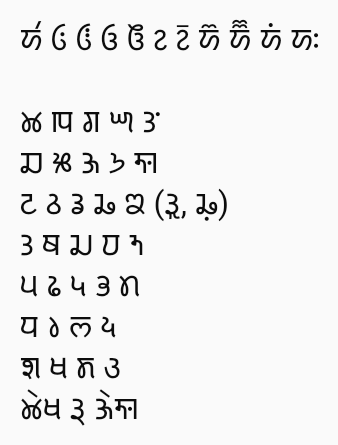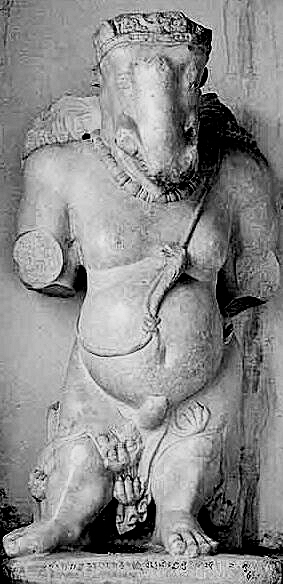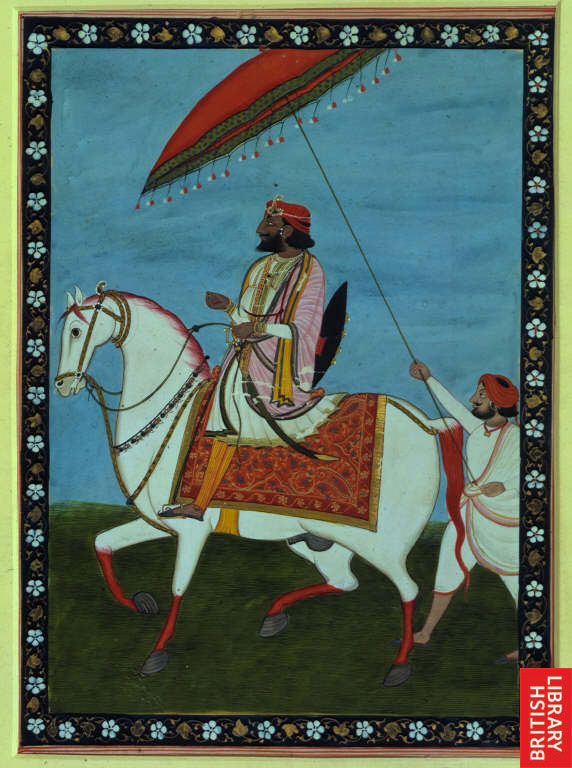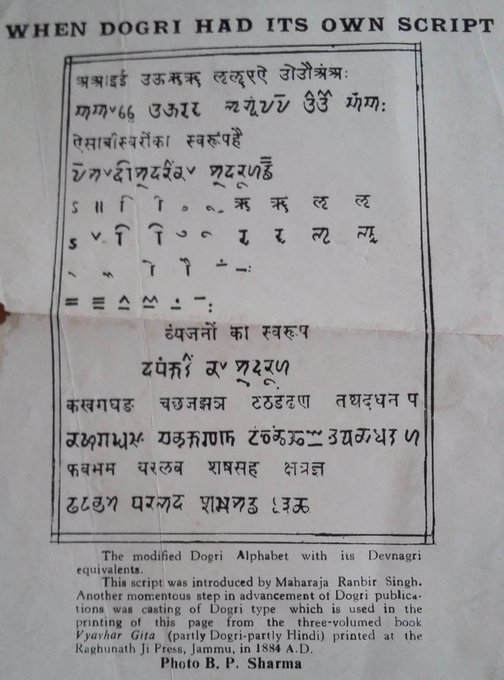|
Takri Script
The Tākri script (Takri (Chamba): ; Takri (Jammu/Dogra): ; sometimes called Tankri ) is an abugida writing system of the Brahmic family of scripts. It is derived from the Sharada script formerly employed for Kashmiri. It is the sister script of Laṇḍā scripts. It is another variant of Dogra Takri (also known as Dogra Akkhar) employed in Jammu region. Chamba Takri was considered by Grierson as the standard form of Takri, primarily because it was the first variety that was developed for print. In addition to Chamba and Dogra, there are numerous varieties, “with each Hill State or tract having its own style.” Until the late 1940s, the adapted version of the script (called Dogri, Dogra or Dogra Akkhar) was the official script for writing Dogri in the princely state of Jammu and Kashmir and for Kangri, Chambyali and Mandyali in Himachal Pradesh. However, the Takri script used in the Sirmour in Himachal Pradesh and Jaunsar-Bawar region has some distinction. History The ... [...More Info...] [...Related Items...] OR: [Wikipedia] [Google] [Baidu] |
Abugida
An abugida (, from Ge'ez language, Ge'ez: ), sometimes known as alphasyllabary, neosyllabary or pseudo-alphabet, is a segmental Writing systems#Segmental writing system, writing system in which consonant-vowel sequences are written as units; each unit is based on a consonant letter, and vowel notation is secondary. This contrasts with a full alphabet, in which vowels have status equal to consonants, and with an abjad, in which vowel marking is absent, Abjad#Impure abjads, partial, or optional (although in less formal contexts, all three types of script may be termed alphabets). The terms also contrast them with a syllabary, in which the symbols cannot be split into separate consonants and vowels. Related concepts were introduced independently in 1948 by James Germain Février (using the term ) and David Diringer (using the term ''semisyllabary''), then in 1959 by Fred Householder (introducing the term ''pseudo-alphabet''). The Ethiopian Semitic languages, Ethiopic term "abugi ... [...More Info...] [...Related Items...] OR: [Wikipedia] [Google] [Baidu] |
Aramaic Alphabet
The ancient Aramaic alphabet was adapted by Arameans from the Phoenician alphabet and became a distinct script by the 8th century BC. It was used to write the Aramaic languages spoken by ancient Aramean pre-Christian tribes throughout the Fertile Crescent. It was also adopted by other peoples as their own alphabet when empires and their subjects underwent linguistic Aramaization during a language shift for governing purposes —a precursor to Arabization centuries later— including among Assyrians who permanently replaced their Akkadian language and its cuneiform script with Aramaic and its script, and among Jews (but not Samaritans), who adopted the Aramaic language as their vernacular and started using the Aramaic alphabet even for writing Hebrew, displacing the former Paleo-Hebrew alphabet. (The modern Hebrew alphabet derives from the Aramaic alphabet, in contrast to the modern Samaritan alphabet, which derives from Paleo-Hebrew). The letters in the Aramaic alphabet all re ... [...More Info...] [...Related Items...] OR: [Wikipedia] [Google] [Baidu] |
Dogri Language
Dogri (Name Dogra Akkhar: ; Devanagari: ý§°ý•ãý§óý§∞ý•Ä; Nastaliq: ; ) is an Indo-Aryan language primarily spoken in the Jammu region of Jammu and Kashmir, India, with smaller groups of speakers in adjoining regions of western Himachal Pradesh, northern Punjab, and north-eastern Pakistani Punjab. It is the ethnic language of the Dogras, and was spoken in the historical region of Greater Duggar. Currently in Districts : Kathua, Jaamu, Samba, Udhampur, and Reasi, it is a majority language. Dogri is a member of the Western Pahari group of languages. Unusually for an Indo-European language, Dogri is tonal, a trait it shares with other Western Pahari languages and Punjabi. It has several varieties, all with greater than 80% lexical similarity (within Jammu and Kashmir). Dogri is spoken by 2.6 million people in India (as of the 2011 census). It has been among the country's 22 scheduled languages since 2003. It is also one of the 5 official languages of the union territory ... [...More Info...] [...Related Items...] OR: [Wikipedia] [Google] [Baidu] |
Jammu Division
The Jammu division (; ) is a revenue and administrative division within Jammu and Kashmir, a union territory of India. It consists of the districts of Jammu, Doda, Kathua, Ramban, Reasi, Kishtwar, Poonch, Rajouri, Udhampur and Samba. Most of the land is hilly or mountainous, including the Pir Panjal Range which separates it from the Kashmir Valley and part of the Great Himalayas in the eastern districts of Doda and Kishtwar. Its principal river is the Chenab. Jammu city is the largest city in Jammu and the winter capital of Jammu and Kashmir. It is also known as "City of Temples" as it has many temples and shrines, with glittering '' shikhars'' soaring into the sky, which dot the city's skyline, creating the ambiance of a holy and peaceful city. Home to some of the most revered Hindu shrines, such as Vaishno Devi, Jammu is a major pilgrimage centre for Hindus. A majority of Jammu's population practices Hinduism, while Islam and Sikhism enjoy a strong cultural heritage in t ... [...More Info...] [...Related Items...] OR: [Wikipedia] [Google] [Baidu] |
Kashmiri Language
Kashmiri () or Koshur (, /k…ôÀê Éur/) is an Indo-Aryan language spoken by around 7 million Kashmiris of the Kashmir region, primarily in the Indian union territory of Jammu and Kashmir. In 2020, the Parliament of India passed a bill to make Kashmiri an official language of Jammu and Kashmir along with Dogri, Hindi, Urdu and English. Kashmiri is also among the 22 scheduled languages of India. Kashmiri has split ergativity and the unusual verb-second word order. Geographic distribution and status There are about 6.8 million speakers of Kashmiri and related dialects in Jammu and Kashmir and amongst the Kashmiri diaspora in other states of India. The precise figures from the 2011 census are 6,554,36 for Kashmiri as a "mother tongue" and 6,797,587 for Kashmiri as a "language" (which includes closely related smaller dialects/languages). Most Kashmiri speakers are located in the Kashmir Valley and other areas of Jammu and Kashmir. In the Kashmir valley, they form a majority. ... [...More Info...] [...Related Items...] OR: [Wikipedia] [Google] [Baidu] |
Sharada Script
The Śāradā, Sarada or Sharada script is an abugida writing system of the Brahmic family of scripts. The script was widespread between the 8th and 12th centuries in the northwestern parts of Indian Subcontinent (in Kashmir and neighbouring areas), for writing Sanskrit and Kashmiri. Originally more widespread, its use became later restricted to Kashmir, and it is now rarely used except by the Kashmiri Pandit community for religious purposes. It is a native script of Kashmir and is named after the goddess Śāradā or Saraswati, the goddess of learning and the main deity of the Sharada Peeth temple. History The Bakhshali manuscript uses an early stage of the Sharada script. The Sharada script was used in Afghanistan as well as in the Himachal region in India. In Afghanistan, the Kabul Ganesh has a 6th to 8th century Proto-Sharada inscription mentioning the, Turk Shahis, king Khingala of Oddiyana. At the historic Markula Devi Temple, the goddess Mahishamardini has a Sh ... [...More Info...] [...Related Items...] OR: [Wikipedia] [Google] [Baidu] |
Brahmic Scripts
The Brahmic scripts, also known as Indic scripts, are a family of abugida writing systems. They are used throughout the Indian subcontinent, Southeast Asia and parts of East Asia. They are descended from the Brahmi script of ancient India and are used by various languages in several language families in South, East and Southeast Asia: Indo-Aryan, Dravidian, Tibeto-Burman, Mongolic, Austroasiatic, Austronesian, and Tai. They were also the source of the dictionary order (''goj≈´on'') of Japanese ''kana''. History Brahmic scripts descended from the Brahmi script. Brahmi is clearly attested from the 3rd century BCE during the reign of Ashoka, who used the script for imperial edicts, but there are some claims of earlier epigraphy found on pottery in southern India and Sri Lanka. The most reliable of these were short Brahmi inscriptions dated to the 4th century BCE and published by Coningham et al. (1996). Northern Brahmi gave rise to the Gupta script during the Gupt ... [...More Info...] [...Related Items...] OR: [Wikipedia] [Google] [Baidu] |
Abugida
An abugida (, from Ge'ez language, Ge'ez: ), sometimes known as alphasyllabary, neosyllabary or pseudo-alphabet, is a segmental Writing systems#Segmental writing system, writing system in which consonant-vowel sequences are written as units; each unit is based on a consonant letter, and vowel notation is secondary. This contrasts with a full alphabet, in which vowels have status equal to consonants, and with an abjad, in which vowel marking is absent, Abjad#Impure abjads, partial, or optional (although in less formal contexts, all three types of script may be termed alphabets). The terms also contrast them with a syllabary, in which the symbols cannot be split into separate consonants and vowels. Related concepts were introduced independently in 1948 by James Germain Février (using the term ) and David Diringer (using the term ''semisyllabary''), then in 1959 by Fred Householder (introducing the term ''pseudo-alphabet''). The Ethiopian Semitic languages, Ethiopic term "abugi ... [...More Info...] [...Related Items...] OR: [Wikipedia] [Google] [Baidu] |
Jammu Division
The Jammu division (; ) is a revenue and administrative division within Jammu and Kashmir, a union territory of India. It consists of the districts of Jammu, Doda, Kathua, Ramban, Reasi, Kishtwar, Poonch, Rajouri, Udhampur and Samba. Most of the land is hilly or mountainous, including the Pir Panjal Range which separates it from the Kashmir Valley and part of the Great Himalayas in the eastern districts of Doda and Kishtwar. Its principal river is the Chenab. Jammu city is the largest city in Jammu and the winter capital of Jammu and Kashmir. It is also known as "City of Temples" as it has many temples and shrines, with glittering '' shikhars'' soaring into the sky, which dot the city's skyline, creating the ambiance of a holy and peaceful city. Home to some of the most revered Hindu shrines, such as Vaishno Devi, Jammu is a major pilgrimage centre for Hindus. A majority of Jammu's population practices Hinduism, while Islam and Sikhism enjoy a strong cultural heritage in t ... [...More Info...] [...Related Items...] OR: [Wikipedia] [Google] [Baidu] |
Chamba District
Chamba is the northwestern district of Himachal Pradesh, in India, with its headquarters in Chamba town. The towns of Dalhousie, Khajjhiar and Churah Valley are popular hill stations and vacation spots for the people from the plains of northern India. Economy In 2006 the Ministry of Panchayati Raj named Chamba one of the country's 250 most backward districts (out of a total of 640). It is one of the two districts in Himachal Pradesh currently receiving funds from the Backward Regions Grant Fund Programme (BRGF). Demographics According to the 2011 census Chamba district has a population of 519,080, roughly equal to the nation of Cape Verde. This gives it a ranking of 544th in India (out of a total of 640). The district has a population density of . Its population growth rate over the decade 2001–2011 was 12.58%. Chamba has a sex ratio of 989 females for every 1000 males, and a literacy rate of 73.19%. The Gaddis, the largest Scheduled Tribe in Himachal Pradesh, mai ... [...More Info...] [...Related Items...] OR: [Wikipedia] [Google] [Baidu] |
Dogri Script
The Dogri script, also known as the Dogra Akkhar script (Dogri: ý§®ý§Æý•áý§Ç ý§°ý•ãý§óý§∞ý§æ ý§Öý§ïý•çý§ñý§∞, ISO: ''Namƒì·πÅ ·∏å≈çgrƒÅ Akkhar'', Dogri pronunciation: …ôm·∫ΩÀê …ñoÀêg…æaÀê …ôkÀê ±…ô…æ is a writing system originally used for writing the Dogri language in Jammu and Kashmir in the northern part of the Indian subcontinent. History Name Dogra Akkhar was created by the order of Maharaja Ranbir Singh of Jammu and Kashmir. It is a modified version of the old Dogra Akkhar script, which in turn was a Jammu variant of the Takri script. Efforts of revival Signboards in Name Dogra Akkhar were erected at Jammu Tawi railway station. However, the script is functionally extinct, with Devanagari being used to write Dogri now. Unicode Name Dogra Akkhar was added as a Unicode block to the Unicode Unicode, formally The Unicode Standard,The formal version reference is is an information technology standard for the consistent encoding, representation, and handling of te ... [...More Info...] [...Related Items...] OR: [Wikipedia] [Google] [Baidu] |
Laṇḍā Scripts
The La·πá·∏çƒÅ scripts, from the term ''la·πá·∏çƒÅ'' meaning "without a tail", is a Punjabi word used to refer to writing systems used in Punjab and nearby parts of North India. In Sindhi, it was known as 'Waniko' or 'Baniya√±'. It is distinct from the Lahnda language varieties, which used to be called Western Punjabi. La·πá·∏çƒÅ is a script that evolved from the ≈öƒÅradƒÅ during the 10th century. It was widely used in the northern and north-western part of India in the area comprising Punjab, Sindh, Kashmir and some parts of Balochistan and Khyber Pakhtunkhwa. It was used to write Punjabi, Hindustani, Sindhi, Saraiki, Balochi, Kashmiri, Pashto, and various Punjabi dialects like Pahari-Pothwari. Variants There are at least ten ancient scripts that were classified as La·πá·∏çƒÅ scripts. They were often used as the mercantile scripts of the Punjab region. 5 of them have enough information to be supported in Unicode. #Gurmukhƒ´ Gurmukhƒ´ ( pa, ý®óý©Åý®∞ý®Æý©Åý® ... [...More Info...] [...Related Items...] OR: [Wikipedia] [Google] [Baidu] |






